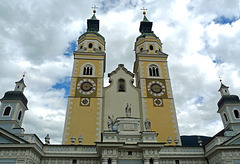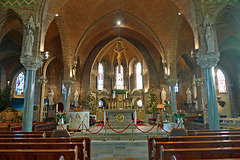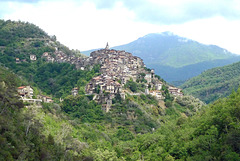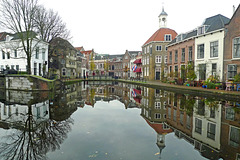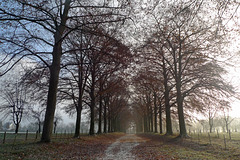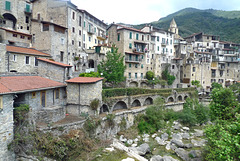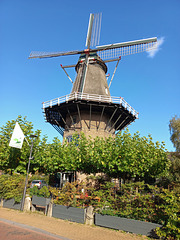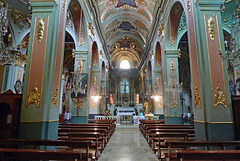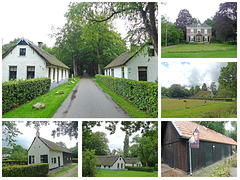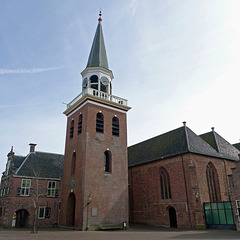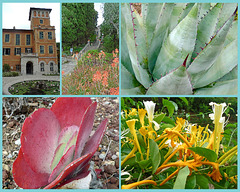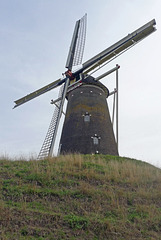Jaap van 't Veen's photos
Italy - Brixen Cathedral
| |
|
|
|
The ‘Dom Mariae Aufnahme in den Himmel und St. Kassian’ (Cathedral of Santa Maria Assunta and San Cassiano) is the largest church in Brixen, once belonging to the powerful Principality of Brixen, nowadays the diocese of Bolzano-Brixen. Although Bolzano is currently the city of residence of the bishop, the most important church in South Tyrol is still the cathedral in Brixen.
The cathedral is dating back to the late 10th century when the main building and its annexes were erected. A fire destroyed the church in 1174. The new Romanesque-gothic building was rebuilt in the baroque style during the period of 1745 to 1755.
The cathedral’s two towers are the landmark of the city of Brixen. The interior of the cathedral is a masterpiece of historical and artistic value. Its wide domed nave is decorated with rich marble and stucco. The main altar has a very striking altarpiece, but the decorative highlight is the fresco on the ceiling.
Nederland - Denekamp, Sint-Nicolaaskerk
| |
|
|
|
The history of the Sint-Nicolaaskerk (Church of Saint Nicholas) is dating back to the year of 1276, when Denekamp was mentioned as a parish for the first time. The church is one of the few religious buildings erected in the region of Twente in the 13th century that is still largely preserved.
The medieval part of the present church consists of a single-bay. As far as this region of the Netherlands is concerned it is the oldest preserved single-bay church, though no longer completely intact.
The medieval parts were built of sandstone from nearby Bentheim. The tower was built against the church in the second half of the 15th century (or early 16th century). Later there were many more enlargements, the last one started in 1910 with the construction of a new transept and choir and apse, which were built with bricks. Architect ‘Te Riele’ also gave the tower - which had been fully closed - an entrance in a pseudo-Romanesque style.
After the reformation the church was used by the protestant minority for about two centuries. In 1809 King ‘Lodewijk Napoleon’ gave back the church to the Catholics. The church is still used for services.
Nederland - Denekamp, Huis Singraven
| |
|
|
|
'Singraven' is an estate near the town of Denekamp. It includes a manor, a garden, a water mill (dating back to1448), a carriage house (1868) and a number of farmhouses. The estate offers a versatile landscape with forests, lanes, fields, meadows, marshes and the ever-present river Dinkel.
Huis Singraven (Singraven Manor) has a rich history. In 1381, the estate is first mentioned as an agricultural farmstead Hof ten Singraven ; property of the bishop of Utrecht. In 1398 the house came into the possession of a family who fortified it into a manor in 1415. After being owned by several families, the estate eventually came into the possession of Willem Frederik Jan Laan. This private owner was the last resident of Huis Singraven .
Mr Laan commissioned several substantial renovations and restorations, including a neo-classical façade. During the period he lived in the house, he amassed a huge art and antiques collection. Mr Laan gave ownership of the estate to the “Edwina van Heek Foundation” in 1956 under the condition that everything should continue to exist in its original state.
Huis Singraven has limited opening hours and can only be visited by a guided tour.
Italy - Apricale
| |
|
|
|
The first written documents about Apricale date back to 1267. The history of Apricale, however, officially begins about two centuries before with the foundation of the castle, wanted by the accounts of Ventimiglia. The place, chosen as a defensive outpost, is called Apricus; around the castle the village develops.
In 1270 Apricale entered the fiefdom of the Doria of Dolceacqua, passing definitively into the sphere of influence of the Republic of Genoa. In the 18th century, Genoa’s difficulties are reflected in Apricale: wars and economic crisis, but also frosts, droughts and famines make it the darkest century in the history of the village, until the French occupation in 1794. In 1815, according to the dictates of the Congress of Vienna, it became part of the kingdom of Sardinia.
Apricale comes from “apricus”, which in Latin means “exposed to the sun”, and in fact, the village is all built on the southern side of the hill. Coming from the Nervia Valley the village seems to be a waterfall of houses surrounded by forested hills. The little mountain village itself is a labyrinth of houses and alleyways.
Nederland - Schiedam
| |
|
|
|
Schiedam was founded in 1230 when the local river the “Schie”, had a dam built on it to protect the existing polders from the North Sea. The dam brought much trade to the area, due to goods being brought to, or transported from the area, to other Dutch towns. The village quickly grew and in 1275 the village received city rights.
Large parts of Schiedam were destroyed by fire in the year 1428, due to most of the buildings being made of wood. But the city was rebuilt and again, flourished. During the 1700’s the production of jenever (gin) started. Soon there were many distilleries in Schiedam. From dozens of distilleries the jenever was traded to many parts of the world and brought great wealth to the city. The gin industry gave the city its nickname 'Black Nazareth'.
Schiedam is known for its historical center with picturesque canals, lined with former warehouses, distilleries and the tallest windmills in the world.
Nederland - Eijsden
| |
|
|
|
Kasteel Eijsden (Castle Eijsden) is a Dutch state monument. The castle is located on the banks of the river Meuse nearby where the small river Voer flows into it.
The picture shows a long driveway with stately trees on the east side of the complex, leading up to a Maria chapel.
Italy - Rochetta Nervina
| |
|
|
|
Archaeological findings testify that the area where Rocchetta stands today has been continuously inhabited since Roman times. During medieval times it was a place through which pilgrims passed on their way from Lower Piedmont through the Nervia Valley: many of the religious buildings in the area served as hospices.
Politically it belonged to an important strategic area called the “County of Nice”. The history Rochetta Nervina is one of a borderland, constantly harassed by fighting and raids between its inhabitants and its neighbours, particularly the Dorias of Dolceacqua .
Today Rocchetta Nervina - with less than 300 inhabitants - still has its medieval appearance, located on the banks of the river Barbaira. The little village is well known for its pools of water (laghetti di Rochetta) in that river (PiP3).
Nederland - Kasteel Eijsden
| |
|
|
|
Kasteel Eijsden (Eijsden Castle) is as a matter of fact a moated manor house. The first building at this site was probably some kind of fortified farm, called the “Caestertburg” or the “Borg”.
The current castle was built in 1636-1637 by Arnold de Lamargelland is located just south of the village of Eijsden next to the river Maas. The house was renovated in 1767 and restored at the end of the 19th century. It is made up out of two angled wings with a heavy cornertower. The eastwing has another towerlike building with a gate towrds the inner square. The castle - built in Mosan renaissance-style - is surrounded by a moat.
Next to the castle is a gatebuilding, built in 1649 when a fire destroyed the earlier buildings. They were restored between 1883 and 1885.
By inheritance the Kasteel Eijsden was owned successively by the noble families Van Hoensbroeck, De Geloes and De Liedekerke, who are the current owners of the castle. It is a Dutch national monument and is part of the Top 100 Dutch heritage sites. The castle is not open for visitors, but the castle park, created around 1900, is freely accessible.
I have visited Eijsden Castle several times before, but never in winter conditions. Glad I was just there during a few cold days and even the sun also just broke through the clouds.
Nederland - Vaassen, Daams Molen
| |
|
|
|
Daams Molen is dating back to the year of 1870. The mill was used by a cattle feed company as a windmill until 1934. In that year, the mill was dismantled and until round 1965 only electric milling was used.
For about twenty years the mill served only as a storage silo. In 1985, there were plans to demolish the mill. Fortunately the foundation Stichting Vaassens Molen made plans to restore the mill. Reconstruction of Daams Molen started in 1989 and one year later the mill was once again running in all its glory as a windmill.
During the restaorstion the original layout was changed quite a bit. Originaly the millstones were on the scaffold (not unusual in this region), but now placed one attic higher. Also, the mill used to be covered not with thatch, but with wood and roofing leather.
As of 2008, the mill was in full discussion because of plans to partly renovate and add new buildings to the center of Vaassen. Due to the expected reduced wind catch, it was necessary to raise the mill. This work started in March 2012. First, the overhead part of the mill was moved about 30 metres, across the street. Then a new foundation with basement was made on the actual site. In May the mill was brought back on the new foundation.
In September the raised Daams Molen was officially put into operation as a grinding mill again.
Since April 2014 the groundfloor houses a lunchroom: Koffie-en Theehuys 'De Korenmolen .
Italy - Dolceacqua, Chiesa di Sant’Antonio Abate
| |
|
|
|
The Chiesa Parrocchiale di Sant’ Antonio Abate (Parish Church of Sant'Antonio Abbot) in Dolceacqua is dating back to the 15th century. Very little remains of its original appearance, as it has undergone numerous interventions over the centuries. Until 1800 it was encompassed by civil buildings. The bell tower was built in 1621, using the watchtower of the city walls.
The church was later renovated in baroque style and is adorned with rich interior decorations and numerous works of art. Among other things it houses the important polyptych of Santa Devota
Nederland - Frederiksoord
| |
|
|
|
After Napoleon was defeated in 1815 Willem I became king of the United Kingdom of the Netherlands (Netherlands and Belgium). High unemployment and poverty are a major problem in the new country. In the cities and rural areas, there is widespread begging: in 1818, nearly one third of the population lives from charity.
The creation of the Maatschappij van Weldadigheid (Society of Benevolence) is prepared. The driving force is general Johannes van den Bosch; other promoters are high officials and the noble elite of the country. Thousands of people across the country and the government itself contribute. The central idea is: we will pay for land and housing; the poor will work to provide for their own maintenance. Eventually the poor would be able to repay their debt to the state, thanks to (agricultural) surpluses.
First, the trial colony Frederiksoord is established. By the end of 1818, 52 little colony houses are ready to receive the poor townspeople. Here they can count on work and shelter. Children are forced to attend school and there is a private health insurance fund. Churches, shops, schools and even rest homes were built. With these social facilities, the Maatschappij van Weldadigheid is 80 years ahead of the rest of the Netherlands and is therefore considered the cradle of the Dutch welfare state.
In addition to an interesting museum - focusing on the history of the colony - Frederiksoord still offers about 50 original buildings from the time of the colony's foundation.
Since 26th of July 2021 Frederiksoord is a UNESCO World Heritage site.
Nederland - Berg en Dal, Duivelsberg
| |
|
|
|
Between the Dutch city of Nijmegen and the (nearby) border of Germany lies the nature reserve Duivelsberg (Devil’s Mountain), characterized by high hills (the top has a height of almost 76 meters) and deep valleys, springs and streams. It is a surprising area with beautiful forests, but also meadows and fields. . The nature reserve covers about 125 hectares (310 acres) and is predominantly covered with deciduous trees, especially chestnut. It is managed by Staatsbosbeheer (Dutch Forestry Commission).
It is politically significant, however, because Duivelsberg is the only part of the Netherlands that was both annexed from Germany and retained after World War II. During the war there was heavy fighting on Duivelsberg during the operation “Market Garden”. After the war the nature reserve - among other small pieces of land along the Dutch-German border - became Dutch territory. In 1963 the Netherlands gave the annexed German territories back to Germany, except Duivelsberg .
The area was for long times a place of great military interest. There was a Roman fortification established 2000 years ago. On Duivelsberg stand two mottes (large earthen hills on which once stood wooden palisades with a tower). A motte is the primitive forerunner of the medieval castle. This particular motte is known by the name “Mergelp” and was probably constructed by count Balderik and his wife Adela around the year 1000.
Italy - Dolceacqua
| |
|
|
|
Dolceacqua (“sweet water”) is situated inland about 10 km from the Ligurian coast along the Nervia river. The town was first mentioned in the year of 1151, when counts from Ventimiglia started the construction of a castle in the hills. The castle was further expanded along with the village in the next centuries.
Dolceacqua is divided into two areas by the river Nervia: the old village known as Terra and Borgo which developed later. The 15th century Ponte Vecchio spans the river and connects the two sections of the village. (Claude Monet visited here twice \and the bridge and village were the subjects of his paintings).
Doria Castle towers high above the maze of narrow streets and alleys of Terra . The Dorias were the last and most famous ruling family of the area. The castle was of course used for defense and to monitor the goings-on of the valley as well as being used as a hideout. It has recently undergone reconstruction since it was in a state of almost complete abandonment.
Nederland - Appingedam, stadhuis
| |
|
|
|
The city of Appingedam developed in the early part of the 12th century, when sailors, merchants and craftsmen settled here, because there was an excellent connection with the open sea. The settlement soon became a flourishing trade and market centre.
In 1630 an excisting Guildhall was converted into a town hall. The upper floor was used as the town hall; the ground floor served as the town weighhouse (until 1825, the weighhouse was still used for weighing pigs).
The (former) town hall of Appingedam is one of the smallest Renaissance town halls in the Netherlands. In 1825 the town hall was extended at the rear to the Nicolaïkerk . The open passageway of the building is very special and gives the building an elegant character. The façade shows among other things a sculpted woman's head with the city arms above it and an almost life-sized statue of an unblindfolded Lady Justice.
Nederland - Appingedam, Nicolaïkerk
| |
|
|
|
The Nicolaïkerk (Nicolai Church) is a hall church with three naves, built in a Romano-Gothic style. This church is the biggest in the province of Groningen, apart from the Martini-church and the A-church which are situated in the city of Groningen.
The building of the church was completed in seven phases between approximately 1200 and 1560. Its construction closely followed the development of Appingedam, the most important harbour in the province of Groningen during the Middle Ages. In the first instance a hall-church was built between 1200 and 1225, consisting of the two first bays of the nave with dome-shaped vaults and a tower.
After several enlargements and addtions, the church became its current shape. The outside measurements are approximately: length = 48 meters, width = 28 meters and from the top of the vault to the floor 13 meters in height.
The first tower of the church was built on the west-side. Mid 16th century that tower was demolished because it was thought that it caused too much pressure on the building. A new built tower was demolished in 1835 due to its condition. The present tower clashes somewhat with the church building.
Originally the church was dedicated to Maria, but changed early in the 15th century to St. Nicholas, patron saint of the sailors and merchants. The Nicolaïkerk is s Dutch national heritage site since 1968 and one of the top 100 sites in the Netherlands.
Italy - Ventimiglia, Hanbury Botanical Gardens
| |
|
|
|
The Hanbury Botanical Gardens (Giardini Botanici Hanbury) have their origin in 1867, when Thomas Hanbury bought the ancient Palazzo Orengo and the adjacent pieces of land, in order to transform them into a garden of exotic plants. Half of the gardens are cultivated with (sub)tropical plants; the other half is occupied by a Mediterranean self-vegetation. In the garden one can discover for instance agaves, aloes, succulent plants, cactuses and citrus and exotic fruits trees.
After some years the garden was well-known because of its richness in plants and the importance of its collection. The Hanbury Botanical Gardens extends on a surface of 18 hectares, nearby the frontier between Italy and France. In 1960 the garden - which was seriously damaged during World War II - was sold to the Italian state. In 1987 the management of the garden was entrusted to the University of Genua. In 2001 the Hanbury Botanical Gardens became also a nature reserve.
We had read many positive reviews about the gardens, but honestly, we were quite disappointed. It made a rather 'withered' impression on us.
Nederland - Bredevoort, De Prins van Oranje
| |
|
|
|
Bredevoort - once a walled city - received permission from Stadholder Frederik Hendrik to build a post mill in 1644. This mill - De Prins van Oranje - was built on one of the city's bastions. After the mill burned down in 1869, the current brick beltmolen (belt = a man-made mound) was built a year later.
De Prins van Oranje remained in operation for almost the entire 20th century, with necessary modernisation taking place. The mill was restored in 1968 and continued to operate thereafter. In 1990, this seemed to have ended due to damage, but repairs followed two years later. The mill is still milling and is often milled by voluntary millers.
De Prins van Oranje is listed as a Dutch national monument.
Nederland - Delden, Kasteel Twickel, tuin en park
| |
|
|
|
Kasteel Twickel (twickel Castle) is well-known for its gardens and park. The gardens have been developed by the various generations and give a good impression of the history since the Renaissance.
The formal garden offers clipped figures of the taxus and buxus trees. The ornamental garden garden in Victorian style has been designed by the last baroness. The surrounding park - with its large water gardens - are developed in English landscape style during the 18th and 19th century. The park has also a wildlife sanctuary with a pack of fallow deer.
The orangery was built in the first half of the 19th century. It serves as a winter residence for the (sub)tropical plants, such as the 300 year old orange trees.
Jump to top
- ipernity © 2007-2024
- Help & Contact
|
Club news
|
About ipernity
|
History |
ipernity Club & Prices |
Guide of good conduct
Donate | Group guidelines | Privacy policy | Terms of use | Statutes | In memoria -
Facebook
Twitter

